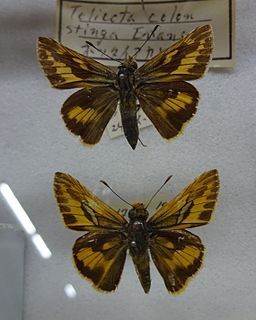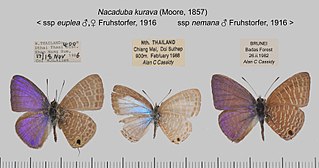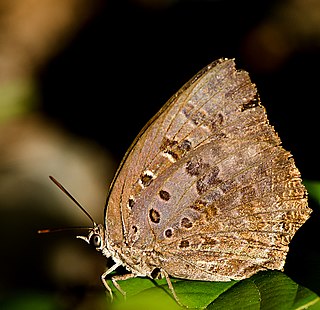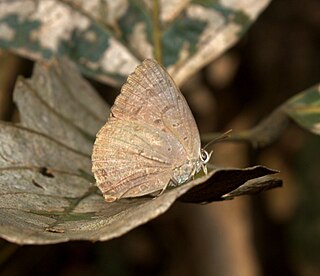
Halpe homolea, the Indian ace or Ceylon ace, is a butterfly belonging to the family Hesperiidae.

Halpe porus, or Moore's ace, is a butterfly belonging to the family Hesperiidae, found in India.

Telicota colon, commonly known as the pale palm dart or common palm dart, is a butterfly belonging to the family Hesperiidae found in India to Australia.

Gomalia is a monotypic genus of hesperiid butterfly. Gomalia elma, the marbled skipper or African marbled skipper, is found in Africa and parts of Asia.

Bindahara phocides, the plane, is a small butterfly found Indomalayan and Australasian realms that belongs to the lycaenids or blues family.

Nacaduba kurava, the transparent six-line blue, is a Lycaenidae butterfly found in Asia and Australia. The species was first described by Frederic Moore in 1857.

Ionolyce helicon, the pointed lineblue, or bronze lineblue, is a small butterfly found in the Indomalayan realm that belongs to the lycaenids or blues family.

Arhopala amantes, the large oakblue, is a species of lycaenid or blue butterfly found in Asia.

Arhopala atrax, the dark broken-band oakblue or Indian oakblue, is a species of lycaenid or blue butterfly found in the Indomalayan realm.

Arhopala centaurus, the centaur oakblue or dull oakblue, is a species of lycaenid or blue butterfly found in India and southeast Asia to the Philippines.

Arhopala bazaloides, the Tamil oakblue, is a species of lycaenid or blue butterfly found in Asia. Also known as Lycaenidae, they are members of the superfamily Papilionoidea, the true butterflies. This family has approximately 4,700 species that are unevenly distributed throughout the world, however the distribution of the Tamil oakblue is limited only to India, Myanmar and Sri Lanka.

Zinaspa todara, the silver streaked acacia blue, is a species of lycaenid or blue butterfly found in South Asia.

Zesius chrysomallus, the redspot, is a species of lycaenid or blue butterfly found in Sri Lanka and India.

Pratapa deva, the white royal, is a lycaenid or blue butterfly found in the Indomalayan realm. The species was first described by Frederic Moore in 1857.

Tajuria jehana, the plains blue royal, is a species of lycaenid or blue butterfly found in Asia.

Tajuria melastigma, the branded royal, is a species of lycaenid or blue butterfly found in the Indomalayan realm.

Horaga onyx, the common onyx, is a species of lycaenid or blue butterfly found in Asia.

Chliaria othona, the orchid tit, is a species of lycaenid or blue butterfly found in Asia.

Deudorix perse, the large guava blue, is a species of lycaenid or blue butterfly found in the Indomalayan realm. It was described by William Chapman Hewitson in 1863. The larva feeds on Randia dumetorum.

Zeltus is a butterfly genus in the family Lycaenidae, the blues. It is monotypic containing the species Zeltus amasa, the fluffy tit, a small butterfly found in Indomalayan realm. The butterfly is found in India, specially the Western Ghats, Sikkim to Assam. It can also be found in Myanmar, Thailand, West Malaysia, Sumatra, Borneo, Java and the Philippines.



















